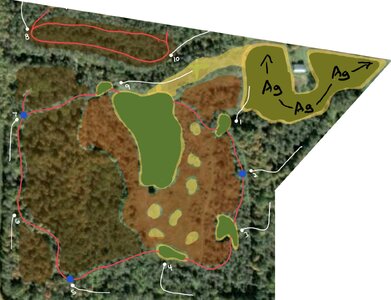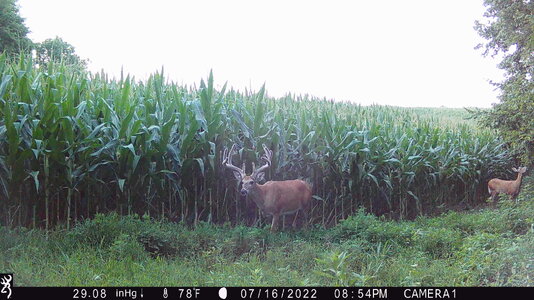First off, congratulations on such a beautiful hunting farm. Properties like yours are not easy to come by, but when you have one they are super fun to take care of.
I like all of your ideas, however, the one I like the best is the soybeans, and the one I like the least is turning the field back to woods. Also, an orchard in tandem with any of these ideas would be a great idea.
Soybeans would, of course, continue the destination plot thing, something that I will discuss more below. Mature woods tend to hold limited value for deer or for property resale, and it's costly to turn woods back into fields. I'd sooner make a permanent early succesional habitat (ESH) field, letting it grow up in saplings and brush, and bush hogging it in alternating strips every 2 years, giving you 4 years of growth between mowings. ESH is one of the ultimate habitats for deer and ESH is also that thick that you could have trail access through it to your other stands without bumping deer.
Back to the destination plot thing,, I have a very similar situation at my own place, my big fields are right around my buildings, right under my nose, and I can sympathize with you, this thing of having destination fields interspersed with stand access roads is not ideal, but it can be made to work, and I've improved access things a bit, something you could possibly do as well, by making some route detours and also planting some cover to lessen bumping deer while moving past destination fields to get to hunting spots.
What ends up happening with human activity around destination fields is that the doe groups tolerate this and live in close proximity to the fields year round, while mature bucks hang out there in the bean fields etc. in the summer, but as hunting season opens and they sense more human activity, they only come to the destination plots at night. So in early archery season the mature bucks are bedding a little further back, and still showing up in the smaller shooting plots in daylight, like at your stands 1, 4, &3, which is exactly where you want them, big bucks concentrated in a small plot within archery range, with the doe groups in the bigger destination fields as the magnet that holds them close, ripe for the picking. I've gotten to the point where I don't mind a bit if we pressure the deer back off of our destination fields, as observation has shown us that they are then more concentrated close by making it easier to harvest one. Getting a particular deer in archery season around a six acre field is almost impossible, get that same deer into a half acre plot makes the hunt easy. But you can't rely on feeding deer year round on half acre plots, they will wipe them out. So you follow what I'm saying, for hunting purposes your almost better to have your destination fields beside your barn, and pressure the deer back into smaller fields for the rut, to get them to a place where you can shoot the one you want.
Just a final observation, considering how mature bucks interact with doe groups, your destination cornfields may have been doing more for your hunting than you realized, I suggest that I wouldn't write corn off just yet.
Also, being that you are in Ohio, you're in the right climate zone to grow summer ladino clover with winter rye, an amazing, balanced year round destination plot species that's cheap and easy to grow and provides almost year round deer food. A large clover/ rye field around your barn with an orchard in the corner might be a nice fit into your setup.



